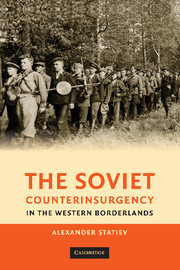Book contents
- Frontmatter
- Contents
- List of Figures
- List of Tables
- Acknowledgments
- Glossary
- Introduction
- 1 Origins of Soviet Counterinsurgency
- 2 The Borderland Societies in the Interwar Period: The First Soviet Occupation and the Emergence of Nationalist Resistance
- 3 The Borderlands under German Occupation (1941–1944): Social Context of the Soviet Reconquest
- 4 Nationalist Resistance after the Soviet Reconquest
- 5 Soviet Agrarian Policy as a Pacification Tool
- 6 Deportations, “Repatriations,” and Other Types of Forced Migration as Aspects of Security Policy
- 7 Amnesties
- 8 Red Rurales: The Destruction Battalions
- 9 Police Tactics: Actions of NKVD Security Units, Intelligence Gathering, Covert Operations, and Intimidation
- 10 The Church in Soviet Security Policy
- 11 Violations of Official Policy and Their Impact on Pacification
- 12 Conclusion: Nationalist Resistance and Soviet Counterinsurgency in the Global Context
- Appendix A Note on Used Terms and Geographic and Personal Names
- Appendix B Note on Primary Sources
- Bibliography
- Index
6 - Deportations, “Repatriations,” and Other Types of Forced Migration as Aspects of Security Policy
Published online by Cambridge University Press: 05 May 2010
- Frontmatter
- Contents
- List of Figures
- List of Tables
- Acknowledgments
- Glossary
- Introduction
- 1 Origins of Soviet Counterinsurgency
- 2 The Borderland Societies in the Interwar Period: The First Soviet Occupation and the Emergence of Nationalist Resistance
- 3 The Borderlands under German Occupation (1941–1944): Social Context of the Soviet Reconquest
- 4 Nationalist Resistance after the Soviet Reconquest
- 5 Soviet Agrarian Policy as a Pacification Tool
- 6 Deportations, “Repatriations,” and Other Types of Forced Migration as Aspects of Security Policy
- 7 Amnesties
- 8 Red Rurales: The Destruction Battalions
- 9 Police Tactics: Actions of NKVD Security Units, Intelligence Gathering, Covert Operations, and Intimidation
- 10 The Church in Soviet Security Policy
- 11 Violations of Official Policy and Their Impact on Pacification
- 12 Conclusion: Nationalist Resistance and Soviet Counterinsurgency in the Global Context
- Appendix A Note on Used Terms and Geographic and Personal Names
- Appendix B Note on Primary Sources
- Bibliography
- Index
Summary
Nado vyselit' s treskom! [Kick them out!]
– Stalin's note on the proposal of the Southern Front Headquarters to deport ethnic Germans
For centuries, states have expelled parts of their populations to other regions within their borders or abroad, seeking to remove from areas threatened by a foreign or internal enemy those whose loyalty they questioned, to facilitate unpopular policies, or to seize lands for more favored groups. Mass deportations differ in principle from the exile of convicts. Convicts are sentenced for certain crimes to specific terms of exile after routine court procedures, whereas deportations are often preemptive, targeting not individuals but groups of potential troublemakers defined on the basis of ethnicity, race, religion, or class, and victims usually are exiled forever by emergency decrees. Depending on the objectives and nature of the state, deportation could be more or less painful to its victims. In the nineteenth century, it was a routine colonial practice, and during World War I, many states exiled or interned citizens who shared ethnicity with enemy nations. Germany deported many Poles and Jews and planned to remove all Slavs from eastern frontier regions, Austria-Hungary expelled Serbs from occupied lands, and Canada interned recent immigrants from Austria-Hungary. In 1915, the Ottomans deported the Armenians who escaped slaughter from the Russian border to Syria. In the 1920s, Greece, Bulgaria, and Turkey exchanged diaspora populations to forestall security problems, and in the 1930s, the Nazis expelled Jews from Germany.
- Type
- Chapter
- Information
- The Soviet Counterinsurgency in the Western Borderlands , pp. 164 - 194Publisher: Cambridge University PressPrint publication year: 2010



